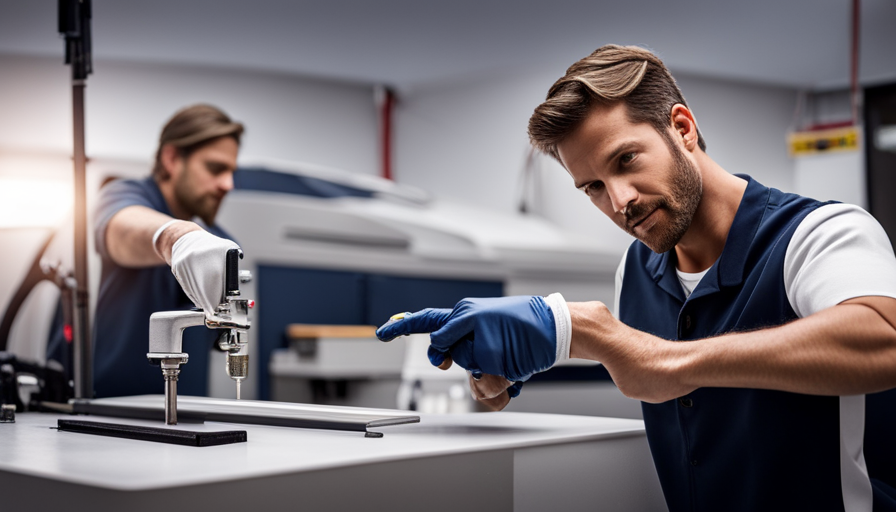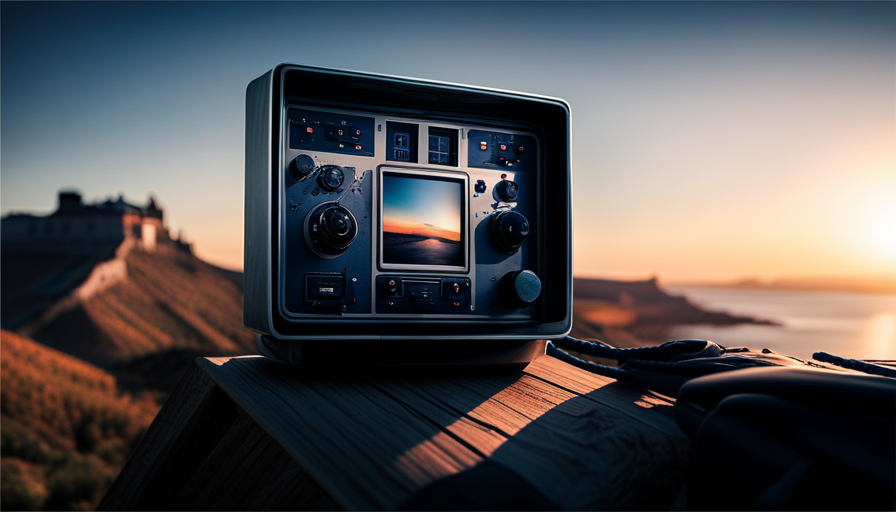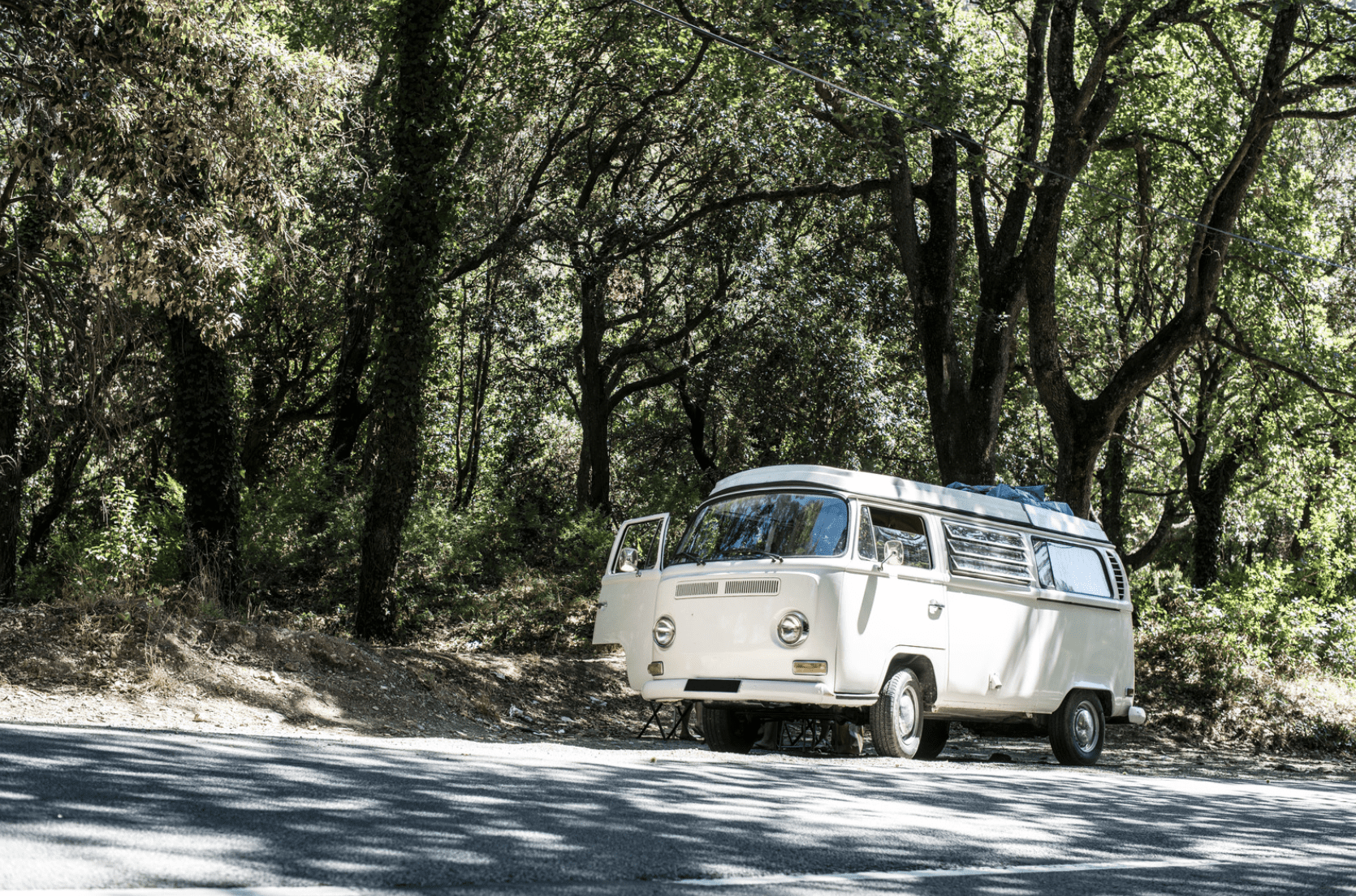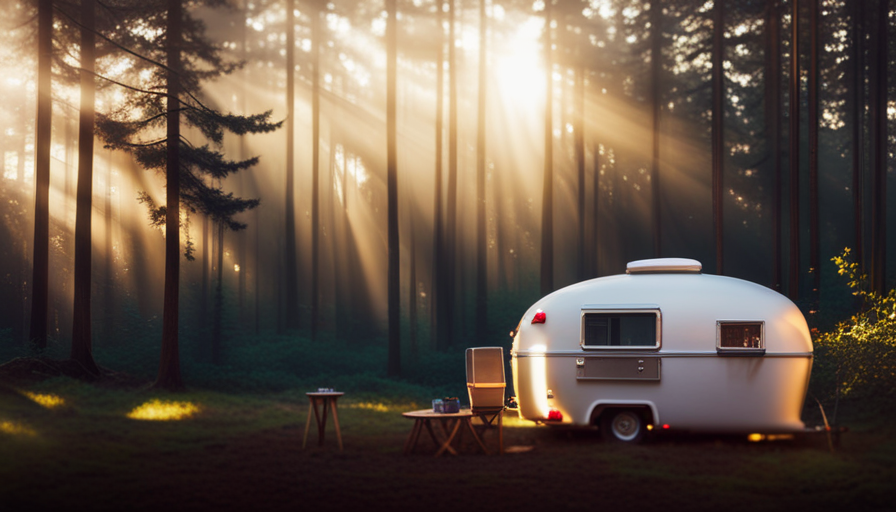I’ve always believed that true freedom comes from living a nomadic lifestyle, where the open road is your home and the whole world is your playground. Making a camper your permanent residence allows you to break free from the constraints of traditional housing and opens up a world of limitless possibilities and adventures.
In this article, I will guide you through the essential steps of living in a camper full time, sharing my personal experiences and expert advice. From choosing the perfect camper for your needs, to setting up your living arrangements and creating a budget, I will provide you with all the knowledge and tools you need to make this lifestyle a reality.
But it’s not just about the practical aspects; living in a camper full time means embracing a mindset of freedom, adaptability, and discovery. I will share tips on maintaining your camper, staying healthy on the road, and embracing the freedom that comes with this lifestyle.
So, if you’re ready to embark on a life of adventure and exploration, join me as we dive into the world of living in a camper full time.
Key Takeaways
- The benefits of living in a camper full time include true freedom from traditional house constraints, constant exploration, and the ability to adapt to life on the road.
- When choosing a camper, consider the size and amenities, understand insurance coverage, and plan living arrangements by researching campgrounds, RV parks, boondocking options, and long-term stay programs.
- Setting up a camper for full-time living involves installing solar panels for power supply, using a water filtration system and composting toilet for water management, maximizing storage space, and adding cozy elements to personalize the interior.
- Managing finances is important, so create a budget, track expenses, list income sources, and identify areas to cut back on spending. Regular maintenance of the camper is also necessary, including inspections, mechanical system upkeep, and troubleshooting common issues. Stay connected and safe by investing in a mobile hotspot, joining online communities and forums, installing a security system, and carrying a first aid kit. Finally, enjoy the benefits of camper living by traveling, engaging in adventure activities, prioritizing fitness and mental well-being, and connecting with other full-time campers through meetup groups and online forums. Cherish memories and experiences by reflecting on the journey, waking up to breathtaking sunrises, exploring hidden gems, finding a sense of belonging in a tight-knit community, bonding over campfire stories, and creating lifelong connections.
Choose the Right Camper for Your Needs
To live in a camper full time, you’ll need to select the camper that best suits your needs. Finding the right amenities is crucial in ensuring a comfortable and enjoyable living experience.
Consider the size of the camper and the amenities it offers, such as a kitchen, bathroom, and sleeping arrangements. Think about your daily routines and what amenities are necessary for you to live comfortably. For example, if you enjoy cooking, a fully equipped kitchen with a stove and refrigerator would be essential.
Additionally, understanding insurance coverage is important to protect your investment and ensure peace of mind. Look for insurance policies that cover both the camper and your personal belongings inside it. It’s also a good idea to consider roadside assistance coverage in case of any unexpected breakdowns or emergencies.
Now that you’ve found the right camper and have the necessary insurance coverage, it’s time to plan your living arrangements and make the most of your new mobile lifestyle.
Plan Your Living Arrangements
When planning my living arrangements in a camper, I made sure to research and find campgrounds and RV parks that suited my needs.
I also explored boondocking and free camping options to add variety to my travels and save on expenses.
Additionally, I considered long-term stays or membership programs to make my living arrangements more affordable and convenient.
Find Campgrounds and RV Parks
Explore various campgrounds and RV parks to discover the perfect spot for your full-time camper lifestyle, where you can soak in breathtaking natural scenery and immerse yourself in a vibrant community of fellow travelers.
When searching for campgrounds, consider the amenities they offer. Some RV parks provide full hook-ups, laundry facilities, swimming pools, and even on-site restaurants. Researching these amenities will help you find the perfect place that meets your needs and preferences.
Additionally, finding affordable campgrounds is important for sustaining your full-time camper lifestyle. Look for campgrounds that offer discounted rates for long-term stays or join membership programs that provide access to a network of affordable campgrounds across the country.
As you delve into the world of campgrounds and RV parks, you’ll also discover the option of boondocking and free camping, which we’ll explore in the next section.
Explore Boondocking and Free Camping Options
Contrarily, the world of boondocking and free camping offers a chance to escape the comforts of modern amenities and truly embrace the raw, untamed beauty of nature. Boondocking refers to camping in remote areas without access to water, electricity, or other facilities. It requires careful planning and preparation, but the rewards are worth it. To find boondocking spots, utilize online resources such as websites, forums, and apps dedicated to sharing information about free campsites. Additionally, consider joining boondocking communities where experienced campers provide valuable tips and recommendations. When boondocking, it’s important to conserve resources and leave no trace behind. Pack enough water, food, and fuel, and be prepared for potential challenges like limited cell service and unpredictable weather conditions. By embracing boondocking, you can truly immerse yourself in nature’s wonders. Transitioning into the next section, let’s consider long-term stays or membership programs for a more sustainable and cost-effective camping lifestyle.
Consider Long-Term Stays or Membership Programs
To fully immerse yourself in the camping lifestyle, consider opting for long-term stays or membership programs that offer sustainable and cost-effective opportunities for extended periods of time.
When it comes to long-term rental options, there are various campgrounds and RV parks that offer discounted rates for extended stays. These options provide you with a sense of community and access to amenities like laundry facilities, showers, and recreational activities. Additionally, some campgrounds offer work-from-home setups, with reliable Wi-Fi and designated workspaces, allowing you to maintain your job even while living on the road.
Membership programs like Thousand Trails and Escapees offer discounted rates and access to a network of campgrounds across the country, giving you the flexibility to travel while enjoying the comforts of a stable home base.
By considering these long-term stay options and membership programs, you can enhance your camper living experience.
Now let’s move on to how to set up your camper for full-time living.
Set Up Your Camper for Full-Time Living
Get ready to transform your camper into the ultimate full-time living space by setting it up just the way you like it. Living off grid in a camper requires careful consideration and planning, but with the right setup, you can enjoy a minimalist lifestyle and embrace the freedom that comes with it.
Here are four important aspects to consider when setting up your camper for full-time living:
-
Power supply: Install solar panels on the roof of your camper to harness the sun’s energy and charge your batteries. This will allow you to live off the grid without relying on traditional power sources.
-
Water management: Set up a water filtration system to ensure a clean and constant water supply. Consider installing a composting toilet to minimize water usage and reduce waste.
-
Storage solutions: Maximize the limited space in your camper by investing in storage containers and organizers. Utilize vertical space and install shelves or hooks to keep your belongings organized and easily accessible.
-
Comfort and personalization: Make your camper feel like home by adding cozy elements such as rugs, cushions, and curtains. Personalize the interior with decorations that reflect your style and personality.
Once you’ve set up your camper to suit your needs, it’s time to create a budget and financial plan to ensure a sustainable and enjoyable full-time living experience. Transitioning into the next section, let’s explore how to manage your finances while living on the road.
Create a Budget and Financial Plan
Start by mapping out your expenses and income to create a budget and financial plan that will guide you on your journey to financial freedom while embracing the nomadic lifestyle. Creating a savings plan is crucial to ensure that you have enough money to cover your expenses and unexpected emergencies. Track your expenses diligently to identify areas where you can cut back and save more. This will help you stay on track with your budget and avoid overspending.
To get started, it’s important to understand your income sources. This could include any regular income you have, such as remote work, freelancing, or investments. Once you have a clear understanding of your income, list out your monthly expenses. This can include campground fees, gas, food, insurance, and any other recurring costs. Be sure to also factor in occasional expenses like repairs and maintenance.
To make it easier to visualize and manage your budget, create a table with three columns: one for your income, one for your expenses, and one for the difference between the two. This will give you a clear picture of your financial situation each month. Adjust your expenses and savings accordingly to ensure you are living within your means and saving for the future.
Creating a budget and financial plan is just the first step in your journey to full-time camper living. In the next section, we will discuss how to adapt to life on the road and make the most of your nomadic lifestyle.
Adapt to Life on the Road
Embrace the freedom of the nomadic lifestyle and adapt seamlessly to life on the road, discovering new horizons and experiencing the thrill of constant exploration.
When living in a camper full time, finding work on the road becomes a priority. Thankfully, there are numerous opportunities available for remote work, such as freelancing, online tutoring, or virtual assistant jobs. These flexible options allow you to earn a living while still enjoying the freedom of the open road.
One challenge you’ll face when living in a camper is dealing with limited storage space. It’s important to be organized and maximize every inch of available space. Invest in storage solutions like collapsible containers, hanging organizers, and under-bed storage bins. Prioritize essential items and declutter regularly to avoid feeling overwhelmed by clutter.
Additionally, maintaining a sense of community and staying connected on the road is crucial. Joining RV clubs or online forums can help you connect with like-minded individuals and find valuable resources. It’s also important to prioritize safety while traveling. Stay updated on weather conditions, have emergency supplies on hand, and ensure your camper is properly maintained.
Transitioning into the next section about ‘stay connected and safe,’ remember that staying connected with loved ones and ensuring your safety are essential aspects of living in a camper full time.
Stay Connected and Safe
Maintaining a strong sense of community and ensuring your safety are vital when living a nomadic lifestyle in a camper van. Here are some tips to help you stay connected while traveling and ensure your safety while living in a camper:
-
Invest in a reliable mobile hotspot or portable Wi-Fi device to stay connected to the internet wherever you go.
-
Join online communities or forums for full-time campers to connect with like-minded individuals and seek advice or recommendations.
-
Install a security system in your camper van, including motion sensors, door/window alarms, and a GPS tracker, to deter theft and enhance safety.
-
Carry a first aid kit and familiarize yourself with basic first aid techniques to handle any minor injuries or emergencies.
-
Research the laws and regulations of the areas you plan to visit, including camping restrictions, road rules, and safety precautions.
By staying connected and prioritizing your safety, you can fully embrace the freedom of camper living. Now, let’s explore and discover new destinations to make the most of this nomadic lifestyle.
Explore and Discover New Destinations
After ensuring that you are connected and safe in your camper, it’s time to embark on the next exciting aspect of full-time camper living: exploring and discovering new destinations. One of the greatest advantages of living in a camper is the freedom to travel and experience different places. From majestic mountains to serene beaches, there are endless possibilities waiting to be explored.
When it comes to adventure activities, each destination offers its unique set of opportunities. Whether it’s hiking through lush trails, kayaking in crystal-clear lakes, or even skydiving over breathtaking landscapes, the thrill of these activities is simply unmatched. Additionally, immersing yourself in the local cuisine is an essential part of the adventure. Trying new dishes and flavors is a delightful way to experience the culture and traditions of each place you visit.
To give you a glimpse of the diverse adventures and mouthwatering cuisines that await you, here is a table showcasing some popular destinations and their corresponding activities and local delicacies:
| Destination | Adventure Activities | Local Cuisine |
|---|---|---|
| Rocky Mountains | Hiking, Skiing, Mountain Biking | Bison Burgers, Trout |
| Coastal California | Surfing, Whale Watching | Fish Tacos, Avocado Toast |
| New Orleans | Jazz Music, Swamp Tours | Gumbo, Beignets |
As you continue to explore new destinations and indulge in thrilling adventures and delicious cuisines, it is important to also maintain your camper and perform regular maintenance. [Transition to next subtopic].
Maintain Your Camper and Perform Regular Maintenance
To ensure a smooth and worry-free journey, it’s essential to regularly maintain and take care of your camper. Performing maintenance tasks and staying on top of regular checks will not only extend the life of your camper but also prevent any unexpected breakdowns on the road. Here are a few key maintenance tasks to keep in mind:
-
Inspect the exterior: Regularly check for any signs of damage, such as leaks, cracks, or rust. Repair or replace any damaged parts promptly.
-
Maintain the mechanical systems: Regularly check the engine, brakes, and tires for proper functioning. Change the oil and filters as recommended by the manufacturer. Keep an eye on the battery and electrical system too.
-
Troubleshoot common camper issues: Familiarize yourself with common problems like plumbing leaks, faulty appliances, or gas system malfunctions. Learn how to troubleshoot and fix these issues to avoid unnecessary expenses.
By performing regular maintenance and promptly addressing any issues, you can keep your camper in top shape and minimize the chances of unexpected breakdowns.
Now, let’s transition into the subsequent section about staying healthy and taking care of yourself while living in a camper.
Stay Healthy and Take Care of Yourself
Make sure you prioritize your well-being and take care of yourself while enjoying the freedom and adventure of traveling in your camper. Living in a camper full time can be an amazing experience, but it’s important to maintain physical fitness and prioritize mental well-being.
To maintain physical fitness, make use of the space you have in your camper. Dedicate a corner for a small workout area with resistance bands, yoga mats, and weights. Incorporate exercises like bodyweight workouts, yoga, and cardio routines to stay in shape.
Additionally, take advantage of outdoor activities like hiking, biking, and swimming to stay active and explore new places.
Prioritizing your mental well-being is equally important. Find ways to relax and unwind, such as practicing meditation or mindfulness. Engage in hobbies that bring you joy, like reading, painting, or playing a musical instrument.
Stay connected with loved ones through regular phone calls or video chats to avoid feelings of loneliness.
By maintaining physical fitness and prioritizing mental well-being, you can fully embrace the freedom and enjoy the journey of living in a camper full time. Remember, taking care of yourself is essential to make the most of this unique lifestyle.
Embrace the Freedom and Enjoy the Journey
When living in a camper full time, it’s important to embrace spontaneity and flexibility in your travel plans. Being able to change course at a moment’s notice and explore new destinations adds an exciting element to the journey.
Additionally, connecting with other full-time camper enthusiasts can provide a sense of community and support, as you can share tips, stories, and adventures with like-minded individuals.
Lastly, cherishing the memories and experiences of camper living is essential. From breathtaking sunsets to unique encounters, these moments are what make the lifestyle so rewarding and unforgettable.
Embrace Spontaneity and Flexibility in Your Travel Plans
Embracing spontaneity and flexibility in your travel plans is like embarking on a wild adventure, where you never know what hidden gems or unexpected surprises await you on the open road.
One of the greatest joys of living in a camper full time is the freedom to embark on spontaneous adventures whenever the mood strikes. With flexible travel plans, you have the ability to change course at a moment’s notice and explore off-the-beaten-path destinations that you may have never considered before. This sense of freedom allows you to truly immerse yourself in the journey and make the most of every opportunity that comes your way.
Whether it’s stumbling upon a breathtaking hike, stumbling upon a charming small town, or stumbling upon a local festival, embracing spontaneity guarantees that your travel experiences will be filled with excitement and wonder. By embracing spontaneity and flexibility, you open yourself up to a world of endless possibilities.
As you connect with other full-time camper enthusiasts, you’ll discover even more incredible destinations and experiences that you may have never known about.
Connect with Other Full-Time Camper Enthusiasts
After embracing the spontaneity and flexibility of full-time camper living, it’s important to connect with other enthusiasts who share the same passion. One of the best ways to do this is by joining meetup groups and online forums dedicated to camper living. These communities provide a platform for exchanging tips, sharing experiences, and even organizing meetups with fellow travelers.
-
Meetup groups offer the opportunity to meet like-minded individuals in person, fostering meaningful connections and friendships.
-
Online forums provide a virtual space to ask questions, seek advice, and gain insights from experienced campers all around the world.
-
Engaging with these communities not only expands your knowledge but also gives you a sense of belonging to a supportive network of individuals who understand the joys and challenges of full-time camper living.
By connecting with other full-time camper enthusiasts, you not only gain valuable information but also create lasting bonds with people who share your love for this unique lifestyle.
Transitioning into the subsequent section, cherishing the memories and experiences of camper living allows us to reflect on the incredible journey we’ve embarked upon.
Cherish the Memories and Experiences of Camper Living
SENTENCE:
Now, as we reflect on our incredible journey, let’s savor every cherished memory and unforgettable experience of living on the road.
| Cherishing Memories | Making New Friends |
|---|---|
| Waking up to breathtaking sunrises | Bonding over shared campfire stories |
| Exploring hidden gems off the beaten path | Creating lifelong connections |
| Embracing the freedom of an ever-changing backyard | Finding a sense of belonging in a tight-knit community |
Living in a camper full time offers a unique opportunity to create lasting memories and forge new friendships. Waking up to picturesque sunrises and exploring hidden gems off the beaten path are just a few of the incredible experiences that make camper living so special. But it’s the connections we make along the way that truly enrich our journey. From bonding over shared campfire stories to finding a sense of belonging in a tight-knit community, the friendships we form on the road become an integral part of our camper lifestyle. So, as we continue our adventure, let’s cherish every memory and embrace the joy of making new friends.
Frequently Asked Questions
How do I handle mail and packages while living in a camper full time?
Handling mail on the road while living in a camper full time can be a challenge, but there are solutions. I recommend setting up a virtual mailbox service that allows you to receive and manage your mail online. This way, you can access your mail from anywhere with internet connectivity.
You can also opt for paperless billing and online shopping to minimize the need for physical mail. Additionally, consider using General Delivery at local post offices for receiving packages while on the move.
What are some tips for finding reliable and safe places to park and stay overnight?
Finding free campsites can be a real adventure! It’s like searching for hidden treasure, except instead of gold, you’re looking for a safe place to park your camper overnight.
Start by checking out online resources like Campendium and FreeCampsites.net. These sites have user reviews and ratings to help you find reliable spots.
Don’t forget to budget for campground fees too, as some places charge a small fee for overnight stays.
Happy camping!
Are there any legal or regulatory requirements I need to be aware of when living in a camper full time?
There are legal requirements and zoning regulations that you need to be aware of when living in a camper full time. These requirements vary depending on the location, so it’s important to research the specific rules for the area you plan to live in.
Some common regulations include obtaining a permit or license, adhering to parking restrictions, and complying with health and safety codes. It’s crucial to familiarize yourself with these requirements to ensure a smooth and legal living experience.
How can I ensure a stable source of income while living on the road?
To ensure a stable source of income while living on the road, it’s essential to explore remote work opportunities and freelance job options.
Did you know that, according to a recent study, the number of remote workers has increased by 140% since 2005? This highlights the growing trend of flexible work arrangements. By tapping into this market, you can find opportunities that align with your skills and interests, allowing you to sustain a steady income while enjoying the freedom of living in a camper full time.
What are some strategies for managing and conserving water and energy while living in a camper full time?
Water and energy conservation is essential for off-grid living in a camper. To conserve water, I use low-flow fixtures, collect and reuse rainwater, and take quick showers.
I also minimize energy usage by using LED lights, propane appliances, and solar panels. I turn off lights and appliances when not in use and insulate my camper to reduce heat loss.
These strategies help me manage my resources efficiently and live sustainably while on the road.
What Are the Benefits of Living in a Camper Year Round?
Living in a camper year-round offers several benefits. It allows for a more simplified lifestyle, saving on living expenses and maintenance costs. You can experience the freedom of constantly changing your surroundings and exploring new adventures. Additionally, living in a camper year-round promotes a stronger connection with nature and encourages a minimalist approach to living.
Conclusion
In conclusion, living in a camper full time has been the most exhilarating journey of my life.
Every day is a new adventure, filled with breathtaking landscapes and exciting experiences.
From choosing the perfect camper to maintaining it regularly, I’ve learned the ins and outs of this lifestyle.
It’s like riding a wave, always moving forward and embracing the freedom that comes with it.
So, if you’re ready to trade the ordinary for the extraordinary, hop on board and let the road be your guide.
Remember, life is a highway, and in a camper, you’re always on the scenic route.










